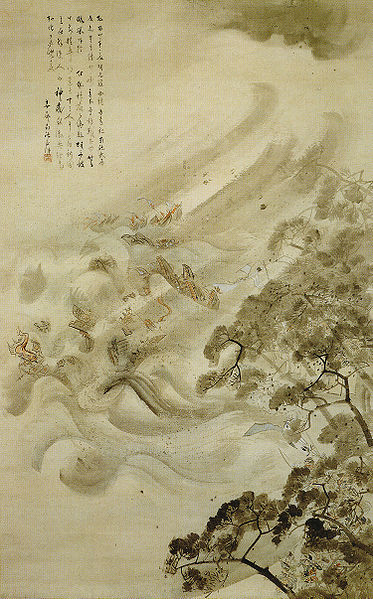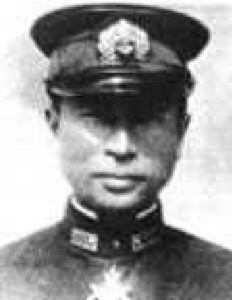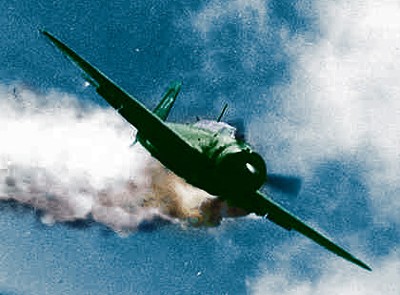
The Kamikaze Pilots of Japan
 The Battle of Bun’ei and the Battle of Kōan were failed Mongol invasion attempts on Japan. It is believed that through divine providence, the Japanese were aided on both occasions by a storm they refer to as Kamikaze (divine wind). The legend of the Kamikaze that brought the mighty Mongol army to their knees became a name used in World War II for aerial suicide attacks by Japanese pilots who gave their lives for honor and loyalty to their country.
The Battle of Bun’ei and the Battle of Kōan were failed Mongol invasion attempts on Japan. It is believed that through divine providence, the Japanese were aided on both occasions by a storm they refer to as Kamikaze (divine wind). The legend of the Kamikaze that brought the mighty Mongol army to their knees became a name used in World War II for aerial suicide attacks by Japanese pilots who gave their lives for honor and loyalty to their country.
Kamikaze during Mongol invasion. Ink and water colors on paper, 1847.
According to an article written in The Guardian by Andrew Chambers, (3 August 2010), “Japan: ending the culture of the ‘honourable’ suicide”, Suicide in Japan is considered a cultural heritage and a noble tradition. The honorable way of dying through one’s own hand is best exemplified with the samurai tradition of seppuku , “self-disembowelment,” also known as “hara-kiri” or belly-cutting. Seppuku was considered a justified response to failure of inevitable defeat in battle. Modern Japanese society’s attitude towards suicide is considered tolerant, stemming from the historical purpose of suicide in the military.
The Kamikaze pilots of World War II were officially known as the Tokubetsu Kōgekitai (特別攻撃隊 “Special Attack Unit”) or Tokkō Tai. Tokkō were suicide attacks by Japanese military aviators against the Allied naval vessels during the final stages of the war in the Pacific. The attacks were designed to inflict heavy damage or completely destroy warships. The Kamikaze strategy was more effective than conventional attacks in causing damage. 3,860 Kamikaze pilots gave their lives with 19% of the attacks effectively managing to hit a ship.
 Rear Admiral Masafumi Arima, the commander of the 26th Air Flotilla (part of the 11th Air Fleet), is credited with conceiving the Kamikaze tactic. Rear Admiral Arima personally led an attack with about 100 Yokosuka D4Y Suisei (“Judy”) dive bombers against a large Essex-class aircraft carrier, the USS Franklin, near Leyte Gulf in the Philippine Sea. Arima was killed when part of his plane hit the USS Franklin.
Rear Admiral Masafumi Arima, the commander of the 26th Air Flotilla (part of the 11th Air Fleet), is credited with conceiving the Kamikaze tactic. Rear Admiral Arima personally led an attack with about 100 Yokosuka D4Y Suisei (“Judy”) dive bombers against a large Essex-class aircraft carrier, the USS Franklin, near Leyte Gulf in the Philippine Sea. Arima was killed when part of his plane hit the USS Franklin.
The Japanese propagandists saw the opportunity to make an example of Arima’s action. Rear Admiral Arima was then promoted posthumously to Admiral and given official credit for the first Kamikaze attack tactic.
 Kamikaze aircrafts were typically converted from conventional aircraft to pilot-guided explosive missiles. Kamikaze pilots would attempt to crash their aircraft into enemy ships, termed a body attack.
Kamikaze aircrafts were typically converted from conventional aircraft to pilot-guided explosive missiles. Kamikaze pilots would attempt to crash their aircraft into enemy ships, termed a body attack.
Lt. Yokosuka D4Y3 (Type 33) “Judy” in a suicide dive against the USS Essex (CV-9), November 25, 1944.
The planes were loaded with a combination of explosives, torpedoes, bombs, and a full tank. The accuracy of Kamikaze tactics was much better than conventional attacks: its payload and explosion were larger.
